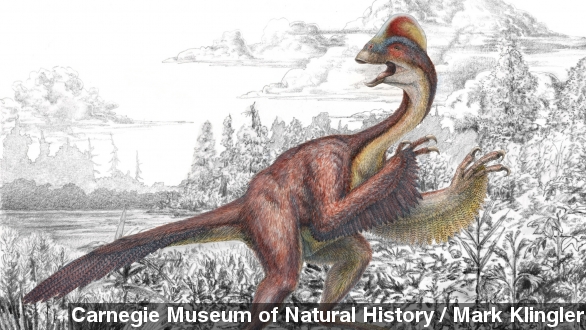U.S. researchers unveiled a huge dinosaur discovery Wednesday. And when we say huge, we mean, like, 10-feet-tall-and-500-pounds huge.
The team, comprised of scientists from the Carnegie and Smithsonian museums and the University of Utah, put together fossils dating back more than 60 million years to discover Anzu wyliei — more affectionately known as the "chicken from hell." And it's really not hard to see why they've given it that name. (Via Carnegie Museum of Natural History)
Researchers discovered the fossils in the Hell Creek rock formation in North and South Dakota. According to The Washington Post, those prehistoric puzzle pieces revealed an animal "with a beak, no teeth, a bony crest atop its head, murderous claws, prize-fighter arms, spindly legs, a thin tail and feathers sprouting all over the place."
Anzu wyliei gets its name from the ancient Mesopotamian mythical figure Anzu, a bird-like demon. (Via Wikimedia Commons / Anton Nyström)
If that isn't enough to sully the newly-discovered dinosaur's reputation, one of the head researchers for the study said, "One [of the Anzu specimens] appears to have a broken and healed rib, and the other has evidence of some sort of trauma to a toe." Translation: It might've been a fighter. (Via The University of Utah)
Of course you can't call something the "chicken from hell" without some interesting responses.
A writer from io9 wants you to imagine outrunning this behemoth. I'd like to turn the tables and think of problems one would have after catching and killing an Anzu.
Think about the "fried chicken sandwich from hell." Or the "chicken wings from hell." There isn't enough ranch or celery on prehistoric Earth to handle all of that. (Via Flickr / avrene, powerplantop)
All jokes aside, the final results of the study took years to come together. According to NBC, the Anzu was closely related to dinosaurs known as oviraptorosaurs, a group of flightless dinosaurs that lived during the Cretaceous Period. (Via NBC)
The Anzu was most likely a vegetarian and once roamed North America. One researcher told the BBC the collection of fossils give an incredibly complete picture as to what the Anzu looked like. And there's more.
"It also greatly increases the diversity of dinosaurs that were alive at the very end of the Cretaceous Period, just before we had the asteroid impact."
He added that it was previously thought dinosaur diversity was on the decline before the extinction event. Anzu suggests otherwise.
The Wire reports two of the partial skeletons are at the Carnegie Museum of Natural History in Pittsburgh. The researchers published their findings in the journal PLOS ONE.


